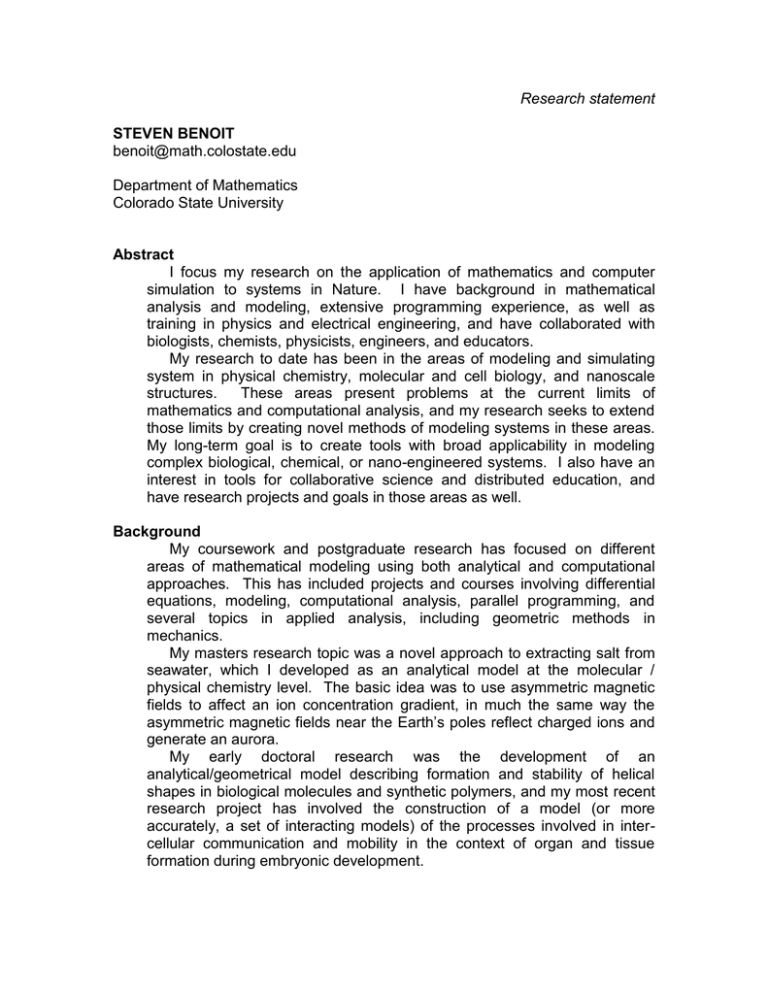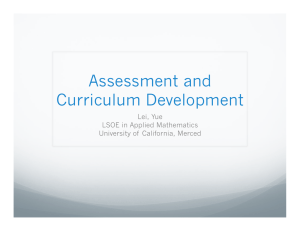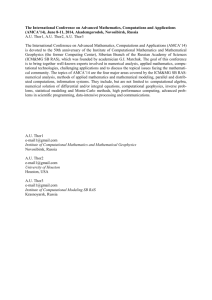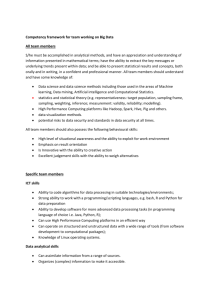Research statement Department of Mathematics
advertisement

Research statement STEVEN BENOIT benoit@math.colostate.edu Department of Mathematics Colorado State University Abstract I focus my research on the application of mathematics and computer simulation to systems in Nature. I have background in mathematical analysis and modeling, extensive programming experience, as well as training in physics and electrical engineering, and have collaborated with biologists, chemists, physicists, engineers, and educators. My research to date has been in the areas of modeling and simulating system in physical chemistry, molecular and cell biology, and nanoscale structures. These areas present problems at the current limits of mathematics and computational analysis, and my research seeks to extend those limits by creating novel methods of modeling systems in these areas. My long-term goal is to create tools with broad applicability in modeling complex biological, chemical, or nano-engineered systems. I also have an interest in tools for collaborative science and distributed education, and have research projects and goals in those areas as well. Background My coursework and postgraduate research has focused on different areas of mathematical modeling using both analytical and computational approaches. This has included projects and courses involving differential equations, modeling, computational analysis, parallel programming, and several topics in applied analysis, including geometric methods in mechanics. My masters research topic was a novel approach to extracting salt from seawater, which I developed as an analytical model at the molecular / physical chemistry level. The basic idea was to use asymmetric magnetic fields to affect an ion concentration gradient, in much the same way the asymmetric magnetic fields near the Earth’s poles reflect charged ions and generate an aurora. My early doctoral research was the development of an analytical/geometrical model describing formation and stability of helical shapes in biological molecules and synthetic polymers, and my most recent research project has involved the construction of a model (or more accurately, a set of interacting models) of the processes involved in intercellular communication and mobility in the context of organ and tissue formation during embryonic development. Current Research I currently have several research projects in progress: 1) Developing a cooperating set of models to describe cell communication and mobility. The challenge in this research is in developing models at a scale appropriate to the problem domain: molecular-based models are too fine-grained and cannot make predictions over the time frames needed (hours or days), and tissue-scale models (typically continuum models) do not contain enough information about the detailed interactions that drive tissue organization. There are few successful models today that address this “meso-scale” domain. This broad project feeds into a number of areas, and I have active research going on in several of these, including: A model of the cell membrane that takes into account elastic and tensile energies, but still allows the membrane to behave like a diffusive liquid surface. A model of chemical signal reception and transduction from the cell’s environment into its interior, creating a gradient that drives cytoskeletal response. A model of the cytoskeleton that includes polymerization, depolymerization, and response to signals passed through the membrane. A model for organelles within the cell, which may limit the extent to which the cell can change shape. A model for adhesion modulation between cells that drives or prevents motion. A model of the extracellular matrix. A computational framework in which these diverse models can be combined for 2- or 3-dimensional simulation and visualization, with the ability to distribute the computing tasks in a networked or supercomputer environment. Analysis techniques for images gathered on a video microscope of cells migrating in live tissue. 2) Modeling of ionic solution response to asymmetric magnetic fields. The goal of this research is to develop optimization methods to determine the best magnetic field distribution to affect the localized ion concentration in solution, with the goal of creating sufficient concentration gradient in the solute to support extraction of ions, with an energy cost substantially below that of current techniques that achieve the same end. Future Research Plan The completion of the computational framework for cell modeling, and implementation of a core set of models that can simulate tissue development over the span of hours or days is a research goal that I will carry forward beyond my doctoral work, since I believe it has broad application and would be beneficial in many areas of biology and biomedical science. Looking beyond the cellular communication project, I believe the general architecture of a system of interacting models in a shared 2- or 3dimensional environment can be applied to many different fields, and I would like to generalize and extend the system to include effects of electrostatic, electromagnetic, and temperature, as well as incorporating more models from mechanics. There area also many areas of research that have been suggested during the course of my current research, including Spontaneous channel formation in crowds or granular media Optimization techniques in surface reconstruction 3-D Voronoi diagrams as models of cells with flat contact zones Extraction of vector fields from sequential frames from video microscopy Reconstruction of 3-dimensional spatial data by varying the focal plane during video microscopy Looking beyond this simulation project, I have several other areas of interests for research, at the intersection of computer science, mathematics, and education. In particular, I would like to develop systems to facilitate collaborative research and online distance education. In particular, I envision a symbolic equation management system with an algebra/calculus engine that allows branched analysis. For example, a researcher would enter a partial differential equation (say, Schrödinger’s equation), then step forward through an analysis (with the engine providing support/validation at each step). Then at some point, an assumption is made (say, “the equation is separable”), and analysis continues down that branch, leaving the other branch (“not separable”) open to further analysis. These branched analyses could then be published to a repository as a vehicle for communication and extensions of understanding of particular equations or systems of equations.






